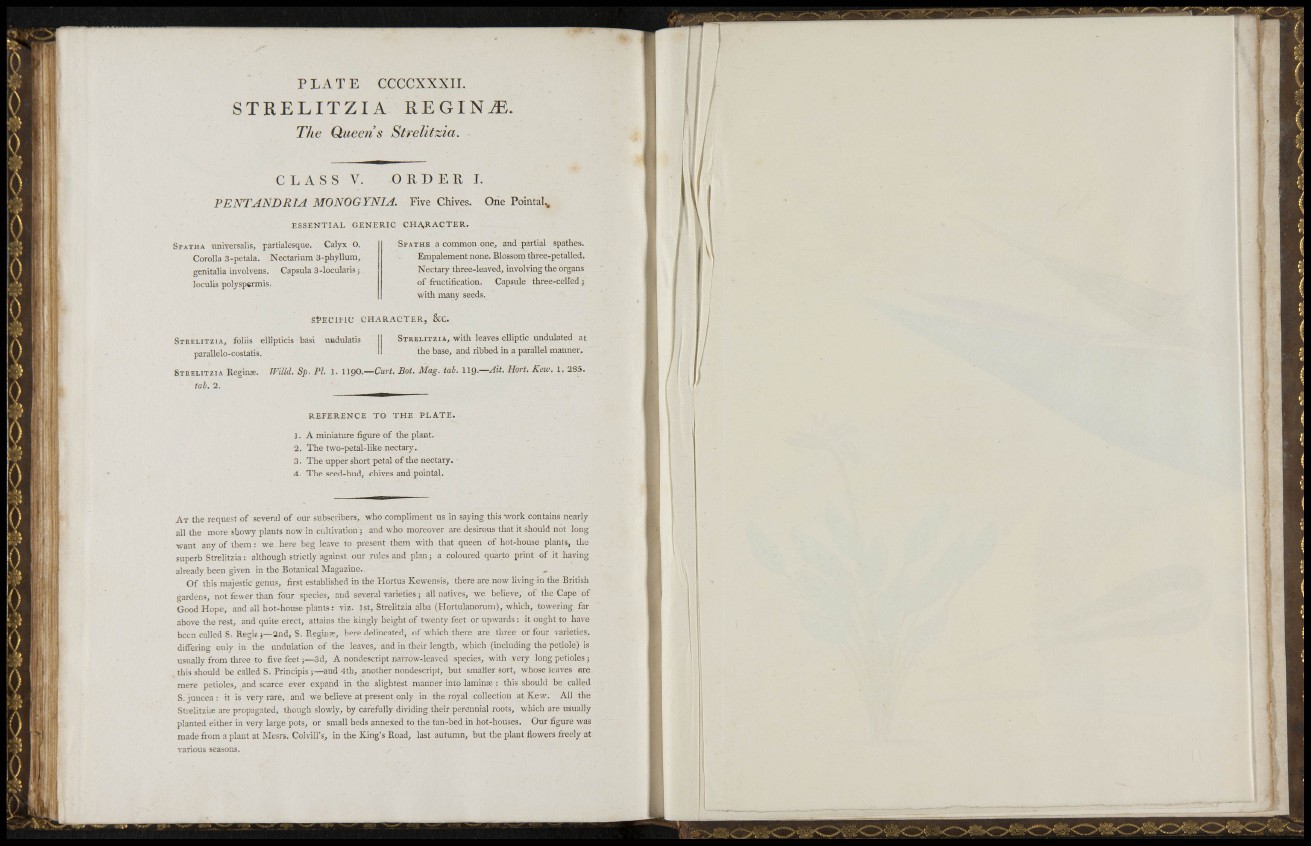
w s m a m
iI
l:i M
»
fl
»
i
i •Ö-J
h i
^ , H
I i
P L A T E CCCCXXXII.
S T R E L I T Z I A REGINtE.
The Queen s Strelitzia.
C L A S S V. O R D E R I.
PENTANDRIA MONOGYNIA. Five Chives. One Pointal.,
ESSENTIAL GENERIC CHARACTER.
SPATHA universalis, partialesque. Calyx 0.
Corolla 3-petala. Nectarium a-phyllum,
genitalia iuvolvens. Capsula 3-locularis;
loculis polyspsrmis.
SPATHE a common one, and partial spathes.
Empalement none. Blossom tliree-petalled.
Nectaiy three-leaved, involving tlie organs
of fructification. Capsule three-celled;
witli many seeds.
SPECIFIC CHARACTER, &C.
STRELITZIA, witli leaves elliptic undulated at
the base, and ribbed in a parallel manner.
STRELITZIA, foliis ellipticis basi undulatis
parallelo-costatis.
STRELITZIA Reginfe. Willd. Sp. PI. 1. II90.—Curi. Bot. Mag. tab. lig.—Ait. Hort. Kew. 1. 285
tal. 2.
REFERENCE TO THE PLATE.
1. A miniature figure of the plant.
2. The two-petal-like nectar)'.
3. The upper short petal of tlie nectary.
4. The seed-bud, chives and pointal.
AT tlie request of several of our subscribers, who compliment us in saying this wor k contains nearly
all the more showy plants now in caltivation ; and who moreover are desirous that it should not long
want any of ihem : we here beg leave to present them with tliat queen of hot-house plants, tlie
superb Strelitzia: although strictly against our rules and plan; a coloured quarto print of it having
already been given in the Botanical Magazine.
Of this majestic genus, first established in the Hortus Kewensis, there are now living in the British
gardens, not fewer than four species, and several varieties; all nati\ es, we believe, of the Cape of
Good Hope, and all hot-house plants: viz. 1st, Strelitzia alba (Ilortulanorum), which, towering far
above the rest, and quite erect, attains the kingly height of twenty feet or upwards : it ought to have
been called S. Regis;—2nd, S. Reginae, here delineated, of which there are three or four varieties,
differing only in the undulation of the leaves, and in tlieir length, which (including the petiole) is
usually from three to five feet j—3d, A nondescript narrow-leaved species, with very long petioles;
this should be called S. Principis;—and 4th, another nondescript, but smaller sort, whose leaves are
mere petioles, and scarce ever expand in the slightest manner into laminee : this should be called
S.juncea: it is very rare, and we believe at present only in the royal collection at Kew. All the
Strelitziae are propagated, thougli slowly, by carefully dividing their perennial roots, which are usually
planted either in very large pots, or small beds annexed to the tan-bed in hot-houses. Our figure was
made from a plant at Mesrs. Colvill's, in the King's Road, last autumn, but the plant flowers fireely at
various seasons.
• i r yf^iâ/ÊtUiSSà,